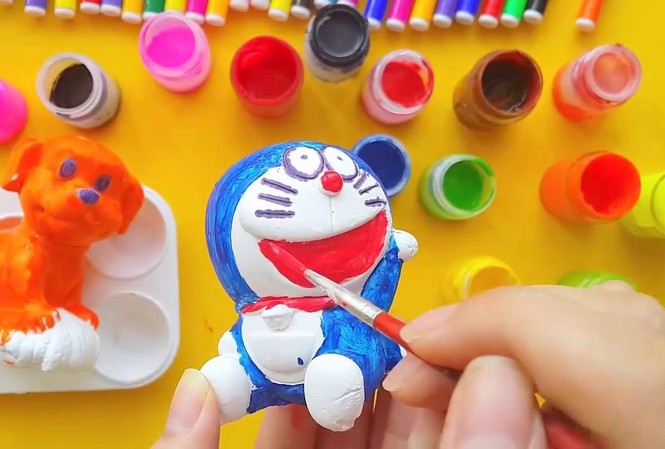Children are susceptible to lead poisoning from paint and crayon.
The use of lead in paint has been banned in many countries around the world, but in Vietnam, this product is not on the list of products that require mandatory quality control. The danger is that water-based paints are present in many games and entertainment activities that children love such as drawing, painting, etc.
 |
Painting and coloring statues are popular with many children, helping to develop their creativity. When taking their children out, parents "enjoy" this game because they don't have to worry about their children running around. However, parents should be careful because the wall paint used to color statues may contain lead, which can easily poison children.
According to Dr. Le Thi Khanh Van (Head of the Department of Neurology, Children's Hospital 2 - Ho Chi Minh City), many children when coming to the hospital for a health check-up, but by chance the doctor saw that the child had black teeth, when asked, they found out that the child had frequent contact with lead-contaminated environments, including lead-contaminated paint; when testing the patient's blood and urine, they discovered lead poisoning.
Explaining this condition, Dr. Khanh Van said that lead poisoning from watercolors often occurs because children use their hands that have watercolors on them to hold food and put it in their mouths, creating conditions for lead metal to enter the body. In addition, there are also a few children who are poisoned by the ingredients in paints due to inhaling the powder.
According to Mr. Nguyen Dung - Head of the Organic Chemistry Laboratory, Faculty of Chemical Technology (Hanoi University of Science and Technology), the principle of children's paint is not to be mixed with wall paint, because wall paint contains many heavy and toxic metal oxides such as lead, cobalt, nickel, cadmium...
White wall paint can reduce toxic substances but not completely, especially paints that are not from reputable brands.
According to chemical experts, when coloring statues, children's skin can easily come into direct contact with paint or children can easily swallow paint, causing the risk of allergies or long-term accumulation of toxic substances in the body. Most of the coloring colors are industrial dyes, often made from organic colors, with unclear origins.
If it is an industrial color or made from metal oxides such as iron oxide, chromium oxide to create red, brown, blue... and it is not yet determined whether it is allowed to be used in children's toys or not. There are types of color mixed with compounds containing benzene-based polymers, which are very toxic to human health, especially children because of the risk of cancer.
For children, the immune system is weak, resistance is weak so they are susceptible to lead poisoning. In adults, the amount of lead absorbed into the body is only about 4 - 10%, however, in children, about 45 - 50% of the amount of lead dissolved in water will be absorbed into the body.
According to Prof. Dr. Nguyen Thi Du (Former Director of the Poison Control Center of Bach Mai Hospital), even the lowest level of lead contamination affects the country's future generations. It impairs memory, reduces IQ, and increases the risk of serious diseases.
In addition, children with lead poisoning also have problems such as anemia, abdominal pain, occasional sleepiness, less playfulness, fatigue, apathy, and slow nervous system development. In rare cases, lead poisoning can cause coma, convulsions, and even death.
This is why in the Philippines many children's watercolor products are being recalled, because they contain high levels of lead and pose a risk of brain damage in children.
According to TPO
| RELATED NEWS |
|---|


